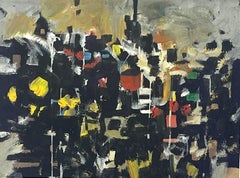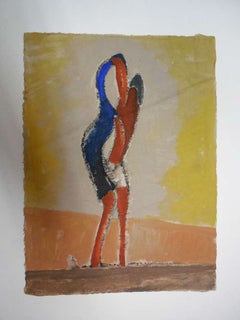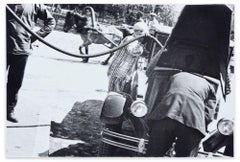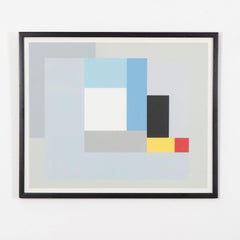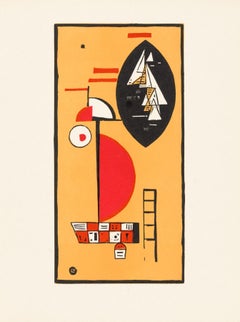Constructivist Art
to
3
3
1
3
2
2
2
1
1
Overall Height
to
Overall Width
to
2,260
549
376
208
109
103
95
88
24
16
3
4
3
2
2
1
1
1
1
1
1
1
64
110
11
6
3
1
3
12
9
9
1
4
1
1
1
1
Style: Constructivist
Period: 1930s
City Nocturne
Located in Lawrence, NY
Irving Lehman was a New York School artist whose work was influenced by constructivism and cubism. He exhibited at the Whitney, the Brooklyn Museum, the Pennsylvania Academy of Fine Art, and many other institutions. This work shows an abstracted view of New York rooftops...
Category
1930s Constructivist Art
Materials
Gouache
Constructivist of Futurist gouache painting
By Ivan Kurach
Located in Surfside, FL
Ivan Kurach (1909 – 1968) Ukranian-Italian lived and studied in Italy. Russian Constructivist or Futurist style work on paper. there is some creasing to the paper but it should lay f...
Category
1930s Constructivist Art
Materials
Paper
Original Vintage Soviet Documentary Film Poster Energy Link Construction Goals
Located in London, GB
Original vintage Soviet movie poster for the 1930 documentary Energy Link / Звено Энергетики celebrating the grandiose scope of energy construction in the USSR directed by Yakov Pose...
Category
1930s Constructivist Art
Materials
Paper
At the Petrol Station - Vintage Silver Salt Photograph by A. Rodcenko
Located in Roma, IT
At the petrol station is an original vintage silver salts photograph, made by the great Russian Constructivist artist Aleksandr Michajlovic Rodčenko (Saint Petersburg, 1891 - Moscow, 1956) in 1935 ca.
Printed later, presumably between the 1940s and the 1950s.
In very good conditions, it is rare and precious. A scene of ordinary life is portrayed in an unusual point of view. The oblique cuts, the use of diagonal as the dynamics of this image, the close position of the machine are constants of Rodčenko'style and something of absolutely revolutionary and innovative at that time in the field of photography!
Provenance:
Museum of Modern Art, Oxford, Great Britain; Forum Auction, London; Private Collection.
Bibliography:
Alexander Rodchenko. Catalog of the retrospective exhibition published from the Museum of Modern Art, Oxford, 1979.
Aleksandr Michajlovič Rodčenko (St. Petersburg, 1891 - Moscow, 1956)
Aleksandr Michajlovič Rodčenko was a Russian painter, photographer and graphic designer, a leading figure of the Russian avant-gardes who collaborated in the establishment of the Constructivist movement.
In 1924 Rodcenko definitively abandoned painting as the main artistic medium to embrace photography...
Category
1930s Constructivist Art
Materials
Photographic Paper
Original 1934 Leningrad Music Hall Theatre Poster For The Seducer Of Seville
Located in London, GB
Original vintage Russian theatre advertising poster for a play performed at the Leningrad Music Hall in 1934, The Seducer of Seville (aka The Trickster of ...
Category
1930s Constructivist Art
Materials
Paper
Escena de recolección de frutas
Located in Miami, FL
Escena de recolección de frutas
BRY-002, 1937
Edition 1/8
Bronze
200 x 113 x 11.5 cm
78.7 x 44.4 x 4.5 in.
ABOUT THE ARTIST
Narváez was born in Porlamar, Venezuela, in 1905; he was the fifth son of eleven siblings; his parents were Jose Lorenzo Narváez and Vicenta Rivera. Don José Lorenzo, a multifaceted and creative man, sowed the seed of creativity in his son. “My father did not fit in with his fantasies of cabinetmaker, bricklayer, master builder, and self-taught architect.”1 From an early age, Francis was led to the artistic activity, he traced, carved, made replicas of the furniture and the saints restored by his father.
In 1920 he obtained his first professional assignment, a San Rafael for the Church of Carupano, and, in 1922, his father authorized him to travel to Caracas to pursue his studies as an artist. He studied at the atelier of Marcos Castillo, at of the Angel Cabre y Magriña and at the Academy of Fine Arts in Caracas, where he was introduced to the painters and intellectuals of the time.
In 1928 he presented his first solo exhibition at the Club Venezuela. With the money raised from the sale of the works and the support of Monsignor Sosa, and the Ministers Centeno Grau and Arcaya, he studied in Paris on a scholarship. Once there, he enrolled at the Académie Julian, where Tito Salas, Cristóbal Rojas and Arturo Michelena had also studied. It was in Paris where, unable to work in wood, he turned to stone carving. “In Paris, I didn’t have wood, so I carved a lot in stone (…), when there were demolitions I purchased chunks of stone, I would take them to the workshop and carve them.”2
His first attempts at volumetric sculptures and painting in plain colours, linked to the thematic of American miscegenation and Creole reality, can be traced back to that first trip to Paris. During his stay in the French city, Arturo Uslar Pietri, Alfredo Boulton, and Finita Vallenilla supported the artist both financially and logistically, and in February of 1930, the trio of friends arranged another exhibition for him at the Club Venezuela. Narváez describes his exhibition as follows: “(…) in it I feel that the sculptural work is more my own, done with more assurance, a response to my pursuit of large planes, stylisation and synthesis.”3 By then, as Boulton himself noted in his book about the artist, Narvaez departed from most of the artistic traditions that prevailed by that time in Venezuela.
In 1931 he returned to Caracas and established his atelier at the Barrio Obrero in Catia. The atelier became the hub of the intellectual life of the time. “In those years, the atelier of Francisco Narváez was the hub of the greatest Venezuelan hope. Nothing comparable to it can be found either before or since.”4
From that year onwards, exhibitions, projects, trips, and awards we multiplied. He was awarded the President of the Republic of Venezuela Prize, the National Sculpture Prize of the 1st Official Venezuelan Art Salon, and the John Boulton Prize of the 3rd Annual Venezuelan Art Salon; for the Military Academy, he produced a spectacular relief entitled La Patria.
In 1945, commissioned by the architect Carlos Raúl Villanueva, he produced two groups of sculptures known as Las Toninas, both located in the O’Leary Square. There, as he himself states, he incorporates some baroque patterns into the figures to the source itself: “It is a work of balance between the decorative requirements and the sculpture of planes and angles.”5
In 1948 he was awarded the National Painting Prize. In the same year, he was called upon by the architect Carlos Raul Villanueva to participate in the project for the arts integration in the Universidad Central de Venezuela. Francisco Narváez’s public output continued with works such as the statue of Fermín Toro, La Educación, La Ciencia, three murals (produced by María Luisa Tovar) for the Instituto de Medicina Experimental, El Cristo; el Atleta, the equestrian statue of General Rafael Urdaneta.
In 1953 he was appointed Director of the School of Plastic and Applied Arts, and in July of the same year, he exhibited “Francisco Narváez, Maderas, Piedras y Bronces” (Francisco Narváez, Woods, Stones and Bronzes) at the Museum of Fine Arts.
Narváez is, unquestionably, one of the great Venezuelan sculptors, his work goes through various stages and interests; as the art world evolves, the artist does not remain in his initial scopes of work. His creations are not imposed by the prevailing trends or fashion but do evolve by experimenting with new materials and interests.
When one peruses the artist’s lengthy list of exhibitions, commissions, and awards, it is worth remembering the Narvaez who embark on his career as a child and who, overcoming obstacles, knew how to make the most of his curiosity. He did not settle for living off his successes. He did not remain stagnant as many creators of his environment did. Narvaez managed to understand the changes in the history of art around him. We must not overlook the fact that Francisco Narvaez is an artist amid all the changes occurring in the art world. He moves from the classics to the great transformations in the art world. It is the Europe of Picasso, Braque, Arp. He observes, he is aware of what is happening in the centres of the world of art, but between his craft and his sensitivity, the result is NARVAEZ, his stamp, and his identity.
Francisco Narváez comes from tradition, and his first stage is linked to the classics, to the exploration of his heritage, but always with his very own language. Throughout his prolific career, he knew how to remain true to himself, without disregarding the influences of his surroundings or his artistic interests: his ability as a sculptor, his selection of materials, whether they were wood, stone or bronze; his choice of the subject of his work…His mastery and great craftsmanship are a constant that over time have made him a leading player in the history of contemporary Venezuelan and world art.
From his beginnings, no subject was foreign to him. His paintings, drawings, aquarelles, and sketches are testimony to his prolific output. Among his themes are portraits, our traditions, still lifes, and landscapes. Narváez is an artist who represents his time. Later, he evolved towards purer and simpler forms, abandoning figurative art for short periods.
In 1956 he declared to the newspaper El Nacional: “Every day I am freeing myself, it is a soul that frees itself from the ephemeral wrappings of the circumstantial always, as well as from the inevitable weight of the anecdote. This second stage of my work is remarkably close to abstractionism, even if there are still certain figures or figurations in the sculptures that I will shortly be showing. However, pure, and absolute abstractionism, it will treat the form itself as the sole reason for its existence on the plane of artistic excellence.”6
The artistic development was his professional life. Each period of his life as an artist, he went one step further, searching, solving, seeing plenty of things and understanding how diverse expressions were transforming themselves. His hands followed his gaze and his mind, always inquisitive. He added movement to the volumes.
Arturo Uslar Pietri, “Formas Nuevas”, Cromotip editions, 1956 “Francisco Narváez is a path: the path that Venezuelan sculpture...
Category
1930s Constructivist Art
Materials
Bronze
Related Items
Lucien Henri Weil " WEILUC" Le Frou Frou French Vintage Poster, Wall Art
Located in Plainview, NY
A fine vintage reproduction of Le Frou Frou French poster originally created by WEILUC (Lucien-Henri Weil, 1873-1947). Le "Frou Frou", which in French mea...
Category
1990s Constructivist Art
Materials
Glass, Paper
Nine Late 19th Century Meiji Period Woodblock Prints
Located in London, GB
Nine late nineteenth century woodblock prints of birds.
Meiji Period.
Held in Giltwood frames with wash mounts.
Category
Late 19th Century Constructivist Art
Materials
Paper, Ink
Four Late 18th Century Hand-coloured Monkey Engravings
Located in London, GB
A group of four late eighteenth century hand-coloured engravings depicting monkeys. Set within giltwood frames
From “Histoire Naturelle des Singes et des Makis Peintres d’après Natu...
Category
18th Century Constructivist Art
Materials
Watercolor, Paper, Ink
Koichi Sakamoto ( 1932 ) Thatched Cottages - Mezzotinto Etching , 11/80 - Japan
By Koichi Sakamoto
Located in Meinisberg, CH
Koichi Sakamoto
(Japanese, 1932)
Thatched Cottages with Mountains beyond
• Mezzotinto etching, sheet ca. 35 x 55 cm
• Plate ca. 20 x 39.5 cm
• Signed bottom right
• Edition 11/80 (...
Category
Mid-20th Century Constructivist Art
Materials
Pigment, Paper
Free Shipping
H 13.78 in W 21.66 in
Abstract -Contemporary, Abstract, Modern, Pop art, Surrealist, Landscape, Nature
Located in London, London
Abstract, 2018
Digital pigment print Ultrachrome ink on Fabriano Rosaspina paper. Hand signed by the artist, and certificate of authenticity. Edition of 25 (Unframed)
His work has...
Category
2010s Constructivist Art
Materials
Paper, Inkjet, Pigment, Archival Pigment
H 15.75 in W 11.82 in D 0.4 in
SAILS XX; SPINNAKER OF THE VELSHEDA
Located in New York, NY
ABOUT THIS PIECE: Since 2008 fine art photographer Jonathan Chritchley has regularly been invited to attend the Classic Yacht Regattas on the legendary Cote d’Azur in France, working...
Category
2010s Constructivist Art
Materials
Photographic Paper
Johannes Sadeler I (Flemish 1550-1600) – Engraving 1582 - Jonah and the Whale II
Located in Meinisberg, CH
Johannes Sadeler I
(Flemish, ∗ 1550 in Brussels, Belgium – † 1600 Venice, Italy)
Jonah Spat Up by the Whale (Sheet II)
Engraved by Sadeler after an image created by Theodor Bernard...
Category
16th Century Constructivist Art
Materials
Laid Paper, Engraving
Free Shipping
H 15.56 in W 13.19 in D 0.6 in
Pastel Constructivist Forms, Soft Tones Geometric Painting, Blue, Pink, Yellow
Located in Barcelona, ES
"Pastel Constructivist Forms" is a hand-painted acrylic painting on high-quality 300g paper by artist Ryan Rivadeneyra. This series focuses on geometric patterns and combinations of...
Category
2010s Constructivist Art
Materials
Oil Pastel, Ink, Sumi Ink, Oil, Acrylic, Watercolor, Archival Paper
Ryan RivadeneyraPastel Constructivist Forms, Soft Tones Geometric Painting, Blue, Pink, Yellow, 2022
Free Shipping
H 28 in W 20 in
Surreal Artwork "The Worshiper of a Beautiful Watering Can", 1965
Located in Washington, DC
Wonderful original surreal artwork by German artist Piet Morell (b.1939). Titled in German "The Worshiper of a Beautiful Watering Can". Signed bottom right. Work is B&W pencil on ...
Category
1960s Constructivist Art
Materials
Paper, Pencil
General Dynamics, Exhibition Dynamic America, New York – Original Vintage Poster
By Erik Nitsche
Located in Zurich, CH
A poster by Erik Nitsche advertising General Dynamics' exhibition "Dynamic America" held 1961 in the newly renovated General Dynamics Building (formerly the Time-Life Building) at the Rockefeller Plaza in New York where the company promoted its achievements. The background to this poster is GD's division Stromberg-Carlson, a telecommunications equipment and electronics manufacturing company, founded 1895 in Chicago and acquired 1955 by General Dynamics (resold 1982). The two Swedish Immigrants started to improve Graham Bell...
Category
Mid-20th Century Constructivist Art
Materials
Paper
Free Shipping
H 35.44 in W 15.36 in D 0.04 in
"Workers" Russian Constructivist 1920s Modern Social Realism Cubism Figurative
Located in New York, NY
"Workers" Russian Constructivist 1920s Modern Social Realism Cubism Figurative
VLADIMIR VASIL’EVICH LEBEDEV (1891-1967)
"Workers"
Gouache on paper
Monogramed lower right
15 1/8 x 10...
Category
1920s Constructivist Art
Materials
Paper, Gouache
A red chalk study sheet by Baldassare Franceschini, known as Volterrano
Located in PARIS, FR
This fresh sanguine sheet presents various studies placed next to each other in no apparent order. Two of the feet studies are preparatory to the first major commission received by the young Baldassare Franceschini, shortly after his installation in Florence, the frescoes for the Medici Fastes. This cycle was executed between 1636 and 1646 for the Villa La Petraia, a Medici villa on the outskirts of Florence, which allows us to date this sheet to the artist's youth.
1. The Medici Fastes, the first major commission for a young artist
Born in Volterra in 1611, the town from which he took his nickname, Baldassare Franceschini apprenticed with his father, a sculptor of alabaster, one of his home town's specialities, and studied with Cosimo Daddi (1540-1630), a local artist. The Marquis Inghirami, who spotted his talent, sent him to the workshop of Matteo Rosselli (1578 - 1650) in Florence, which was also attended by Francesco Furini (1603 - 1646).
In 1636, Lorenzo de' Medici, the youngest son of Ferdinand Ier and Christine of Lorraine, chose the 25-year-old artist, again on the advice of the Marquis Inghirami, to decorate with frescoes the loggias of the inner courtyard of the Villa La Petraia, which he had just inherited on the death of his mother. The project lasted about ten years and included ten scenes placed symmetrically in two loggias on either side of the courtyard: four main scenes and six placed above the doors, each to the glory of a member of the Medici family.
This decoration was his major secular project, but Volterrano also executed several religious frescoes and a few easel paintings, often with less success. Among the religious commissions, we can cite the dome of the Colloredo chapel dedicated to Saint Lucy...
Category
Mid-17th Century Constructivist Art
Materials
Chalk, Paper
Previously Available Items
June 1937
Located in Toronto, Ontario
Ben Nicholson (1894-1982) was one of the leading British Modernist artists who had a significant influence on the direction of sculpture.
This iconic print was made after his epony...
Category
1930s Constructivist Art
Materials
Lithograph
Woodcut for Editions “Cahiers d'Art”
Located in San Francisco, CA
Original woodcut printed in three colors (yellow, red, black) from three blocks on Torpes wove paper
Signed in the block with the artist's monogram (a “K” in an angle) lower left.
...
Category
1930s Constructivist Art
Materials
Woodcut
June 1937
Located in Toronto, Ontario
Ben Nicholson (1894-1982) was one of the leading British Modernist artists who had significant influence on the direction of sculpture.
This iconic print was made after his epony...
Category
1930s Constructivist Art
Materials
Lithograph
Original vintage USSR propaganda poster: complete the 5 Year Plan in 4 years
By Ganf (Yang) Iosif Abramovich
Located in London, GB
Original vintage propaganda poster issued in the USSR to motivate completion of the Five Year Plan in four years. Joseph Stalin's economic plan was based on his policy of Socialism i...
Category
1930s Constructivist Art
Materials
Paper
Constructivist of Futurist gouache painting
By Ivan Kurach
Located in Surfside, FL
Ivan Kurach (1909 – 1968) Ukranian-Italian lived and studied in Italy. Russian Constructivist or Futurist style work on paper. there is some creasing to the paper but it should lay f...
Category
1930s Constructivist Art
Constructivist art for sale on 1stDibs.
Find a wide variety of authentic Constructivist art available for sale on 1stDibs. Works in this style were very popular during the 21st Century and Contemporary, but contemporary artists have continued to produce works inspired by this movement. If you’re looking to add art created in this style to introduce contrast in an otherwise neutral space in your home, the works available on 1stDibs include elements of blue, orange, red, green and other colors. Many Pop art paintings were created by popular artists on 1stDibs, including Antony Squizzato, Ryan Sarah Murphy, Natalia Roman, and Henk van Putten. Frequently made by artists working with Paint, and Paper and other materials, all of these pieces for sale are unique and have attracted attention over the years. Not every interior allows for large Constructivist art, so small editions measuring 4 inches across are also available. Prices for art made by famous or emerging artists can differ depending on medium, time period and other attributes. On 1stDibs, the price for these items starts at $1 and tops out at $850,000, while the average work sells for $1,950.
Recently Viewed
View AllMore Ways To Browse
Wall Fresco
19th Century Spanish Paintings
Greek Woman
Oil Painting Man 19th
Native American Gold
Cut Paper Wall Art
Antique Painting Auction
Antique Painting Auctions
Japanese Painting Gold Leaf
Gold Leaf Painting Japan
Lady Just
Sea Life Gold
Canvas Midcentury Print
Costa Vintage
Russian Vintage Fashion
Coat Mans
Head Of Man Sculpture
Sculpture 1942
